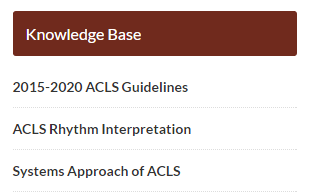ACLS Practice Exam Questions and Answers
※ Download: Acls post test answer key 2018
Thomas James, Director of Customer Experience. Have another nurse to double check the presence of a pulse. Turn it off and back on again. We have selected 20 questions 10 questions for BLS that cover many topics that will be tested on the certification examination.

He was discussing his latest project when he started sweating and then lost consciousness. Also get a quick glimpse of dosages for adult tachycardia with pulse. ACLS Pre-Course Self Assessment.

ACLS Practice Test - Answers are at the bottom of the page.

Compare and contrast a list of previous and current recommendations. Also, learn the difference between CPR with one rescuer and CPR with two rescuers. Further, learn about the Chains of Survival for adult and pediatric care. Use the provided diagrams to thoroughly engage yourself in the step-by-step CPR process. Familiarize yourself with inserting basic airway adjuncts and the knowledge of advanced airways and its equipment. Review the provided table to reference information about adult drug dosage, routes, and uses of common drugs. Systems of care describe an organization of professionals necessary to respond during emergencies and in any given circumstances. Get your hands on the STEMI Chain of Survival and further learn the goals of ACS treatment. Learn about what you can bring to the table as a leader or as a member of the resuscitation. Get familiar with tasks to do as a nurse, physician, or even a family member during the event of a cardiac arrest. Further, get to know the types of ventilation advanced and basic and the techniques of placing the airways. These rules include guidelines for regularity, rate, waves, intervals, and complexes for all three cases. Further, learn how about the quality of CPR you give, shock energy, return of spontaneous circulation ROSC , advanced airway, drug therapy, and reversible causes of cardiac arrest. Learn how blood pressure support, vasopressors, and hypothermia help during post-cardiac arrest care. These rules include guidelines for regularity, rate, waves, intervals, and complexes for all cases. Further, also get a glimpse of symptoms of bradycardia. Also, learn about the symptoms of tachycardia, and what to do in the event of tachycardia pulse being higher than 100 BMP symptomatic. These rules include guidelines for regularity, rate, waves, intervals and complexes for all cases. Also, learn about the symptoms of tachycardia, and what to do in the event of tachycardia pulse being higher than 100 BMP symptomatic. Also get a quick glimpse of dosages for adult tachycardia with pulse. Further, review the goals set by National Institute of Neurological Disorders and Stroke NINDS for situations when the time of symptom onset is known.
Further, learn how about the quality of CPR you give, shock energy, return of spontaneous circulation ROSCadvanced airway, drug therapy, and reversible causes of cardiac arrest. What drug should you consider giving in all Acute Coronary Syndrome ACS patients. Though many resources are available that will help you study for your ACLS certification exam, few can match the level of preparation and feedback offered by practice exam question and answers. Do nothing until the AED arrives. Please enter the code found at the bottom of page ii in the front of your course manual to access the student supplementary materials for your course. What is the next step. Learn about what you can bring to the table as a leader or as a member of the resuscitation. He has received multiple doses of epinephrine and the monitor now shows asystole.



